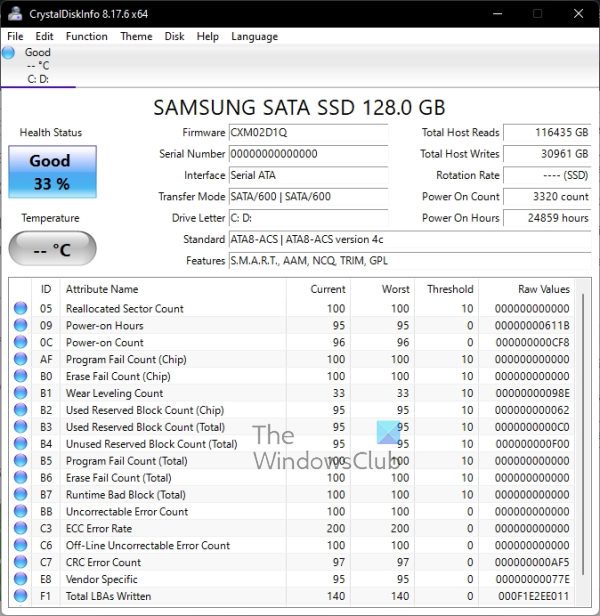

The program's system tray icon displays a selected disk's temperature and accesses a Collective Settings submenu that makes it easy to set common parameters such as Alarm Settings for temperature and Health Status. Under Health Status Settings, we could set Thresholds of Caution for our HDD's sector counts. It will also display the S.M.A.R.T data and provides a health rating based on your drive's SMART. We could also set up mail alerts, view the event log, and more. CrystalDiskInfo displays basic HDD information, monitors S.M.A.R.T. Under Advanced Features, we found the AAM/APM Control console (with an Auto Adaptation option). But the Function menu contains the most interesting stuff, such as a separate Graph that can display dozens of disk parameters, startup and temperature display options, workarounds, and the ability to open the Windows Device Manager and Disk Manager directly. The program's settings include interface languages, fonts, and copy options. The second tab showed our HDD's data, including Rotation Rate.


CrystalDiskInfo displays detailed SMART data in the optional bottom view under a variety of headings. Under Features, it showed that our SSD was compatible with SMART, TRIM, and NCQ as well as 48-bit Logical Block Addressing (LBA). But CrystalDiskInfo displayed a lot of useful data, including Power On Count and Hours, Host Reads and Writes, Firmware version, and Standards. Many SSDs lack temperature sensors ours included, so the temperature read zero degrees. CrystalDiskInfo displayed its name, model number, and capacity. The program opened with our C drive, an SSD. How to Check SSD Health in Windows 10 and Windows 11 Click the Search button from the Taskbar Type in CMD and hit enter Type WMIC and hit. Selecting any drive's icon displays its details in the main view. In fact, if you bought an SSD in the last couple of years, research from Backblaze shows that SSDs have lower failure rates than hard disk drives and can be expected to perform for longer.CrystalDiskInfo's user interface displays your drives' health status and temperature sensor data (where available) in a bar along the top of the window. Typically, SSDs should last many years, likely far longer than you'll need them, so you shouldn't worry or be paranoid. The question that emerges in this situation is, "How long do SSDs last?" The other possible problem with SSDs is that they have limited read/write cycles, an issue that exists with all kinds of flash memory. In fact, in the case of a power failure, SSDs have also been known to corrupt existing data, even if the drive itself hasn't failed completely. It displays basic HDD (also SSD and USB-HDD) information, monitors S.M.A.R.T. SSDs require a capacitor and power supplies, which are vulnerable to malfunctions-especially in the case of a power surge or power failure. CrystalDiskInfo is a HDD/SSD health monitoring utility. However, while SSDs aren't susceptible to mechanical failure, other components are. Unlike in HDDs, there are no physical moving platters in SSDs, so they're immune to old hard disk issues.


 0 kommentar(er)
0 kommentar(er)
